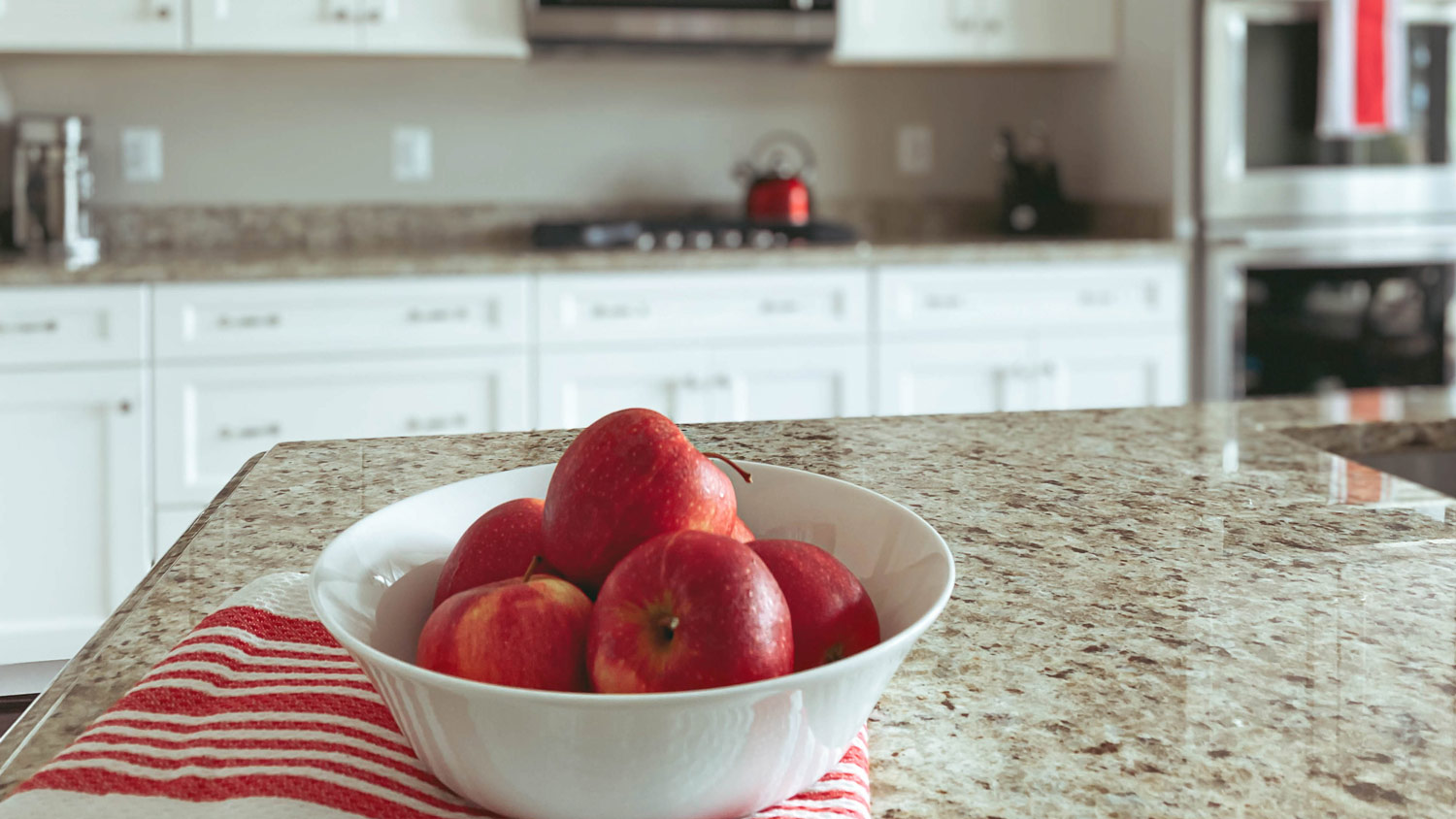How to Seal Granite Countertops: A Complete Guide
A spilled glass of grape juice isn’t worth remembering


Granite countertops are beautiful, but it takes staying on top of cleaning to keep them that way. Learn how to seal granite countertops before everyday use leaves stains; even the smallest squeeze of lemon can cause permanent marks on the countertop if you don’t wipe up juice quickly. Sealing a granite countertop can help reduce the risk of stains and keep your stone surfaces looking gorgeous.
When to Reseal Your Granite Countertops
You don’t have to seal all types of granite; some countertops are presealed. If you’re unsure, you can look for signs that your granite needs a fresh seal. If you see fissures, etch marks, or moisture rings, your granite countertop needs sealer.
The general rule of thumb is to reseal your granite countertops once per year or if you plan to sell your home. If you’re an avid home chef or baker, you might want to seal them more often. Follow the instructions that come with the sealant. The different colors of granite counters can make a difference, too. White, bright countertops will be more prone to staining, so they might need sealing more often. Darker granite is denser, making it less likely to stain and discolor. Plus, dark colors hide stains better.
You can also try the water test: Pour 1 tablespoon of water on the counter, walk away for 15 minutes, and then come back with a clean, dry cloth and wipe it up. Does the countertop appear darker than the surrounding areas? If so, it needs a sealer—don’t worry, the darkened spot is temporary. Since the underside of the countertop isn’t sealed, water that soaks in will evaporate after a few hours.
How to Seal Granite Countertops

If you choose to seal your own countertops, roll up your sleeves and follow these steps.
1. Determine If Your Countertop Needs a Sealant
You can confirm that your granite countertop needs a new coat of sealant with a quick test.
Choose an edge or corner and add a few drops of water to the counter.
Add oil (like vegetable or olive) on the surface a few inches away from the water.
Let both the oil and water sit on the countertop for about 15 minutes.
When you return, check to see if the water and oil seeped into the granite. Wipe any remainder up and examine the countertop. Did it darken?
If the granite surface of your countertop has darkened, the countertop needs sealing. If not, your granite countertop already has a seal, and you get to cross something off your to-do list.
2. Remove Old Sealer If Necessary
If you need to get rid of the existing layer of sealer on your granite countertops before applying a new one, you have a few material options. You can use mineral spirits, acetone, or isopropyl alcohol to remove old sealant. These methods should strip away the existing sealant layer, but if not, hire a countertop pro to determine the issue and finish the task.
3. Clean Your Countertops
Before applying granite countertop sealant, use a microfiber cloth to remove any dust or crumbs. Then clean the granite counter with warm water and soap. After thoroughly washing, spray the countertop with a mixture of 2 tablespoons of rubbing alcohol for every teaspoon of dish soap.
Use a microfiber cloth to rub the spray in a circle, creating a polish on the surface.
Let the granite dry for 24 hours before the next step, so you don’t seal any moisture into the granite.
4. Test the Sealant
Before starting, make sure you’ve read the directions on your sealant.
Put on gloves, and opened a window for ventilation.
Apply an even coat of sealant over a small test area and allow it to sit according to the manufacturer’s instructions (usually 15 minutes).
If you notice any discoloration, wipe off the sealant. Contact a local granite countertop pro to ask if they can assess the situation, offer a solution, or recommend a product that might work better.
5. How to Apply Sealant
Next is the actual sealing part of the process.
Work your way from top to bottom and side to side.
Apply the sealant using circular motions. Try to keep your circles the same size to work your sealant into every last centimeter.
Allow the sealant to penetrate the surface as indicated on the product’s label—usually about 15 minutes. The recommended time between coats can vary.
Remove any excess sealant and then walk away. The seal needs to cure for about 48 hours.
Should You DIY or Hire a Pro to Seal Granite Countertops?
Sealing your granite countertops is a simple process you can do on your own, and the sealant costs about $20. The process takes less than an hour of hands-on time and some periods of waiting—total time varies depending on how much surface space you have. Countertops need to be resealed every year, depending on how much you use them.
If you’d prefer to leave the task to the pros, expect to pay between $170 to $350. When local granite countertop pros do the job, the seal can last longer. It might be worth hiring a pro to seal the countertops in a bigger kitchen or if you need other kitchen countertop repair work or done at the same time.
Why Do I Need to Seal Granite Countertops?
Granite countertops have many benefits, but granite is a porous stone, meaning liquids can work their way inside. Any liquids that aren’t promptly wiped up seep into the little nooks and crannies deep in your pretty countertops. Dark liquids and acids, like lemon or tomato juice, are particularly problematic.
The best way to avoid a reminder of the time apple slicing got a little out of hand or the merlot that spilled all over the counter during that awesome birthday bash is to seal the granite periodically.
Sealed granite isn’t a guarantee of no stains ever, but it does slow orange juice’s absorption into the counter and helps prevent etching. Penetrating sealer seeps into the stone and fills little gaps where the merlot would otherwise end up. Topical sealers sit on the stone's surface, making it shiny and fresh looking.
Frequently Asked Questions
Check the label on the product you select. Some granite countertop sealers are color-enhancing, whereas penetrating sealers should only temporarily darken the granite color. Keep in mind that the granite will appear darker when the sealer is initially applied, but it will return to its usual color once the sealant is wiped off 10 to 15 minutes later.
Gentle dish soap and water are all you need to remove spills, splashes, and sticky messes from granite countertops. As you go through your kitchen cleaning checklist, make sure to give the countertops a once over. Avoid using harsh cleaners, baking soda, and vinegar because they can stain granite and permanently change the stone’s appearance.
Acidic liquids left on granite countertops dull the stone’s surface. This is called etching and is permanent.
Granite stains happen when liquid seeps into the countertop. Juice is a common offender since it’s often brightly colored. The orange, red, or purple becomes a permanent part of the countertop.
Sealing countertops helps slow the absorption of liquid into the stone, reducing the risk of both staining and etching.





- How Long Do Granite Countertops Last?
- How to Change the Color of Your Granite Countertops for a Brighter Kitchen
- How to Choose Between Epoxy vs. Granite Countertops: Everything You Should Consider
- Sink Your Teeth Into Granite Sink Cutouts
- How To Paint Countertops: A Step-by-Step Guide
- How to Cut Countertops for a DIY Kitchen Reno
- How to Epoxy Countertops in 8 Steps
- Do Quartz Countertops Need to Be Sealed? Find Out the Answer
- Laminate Countertop Pros and Cons
- How to Cut Laminate Countertops Like a Pro










